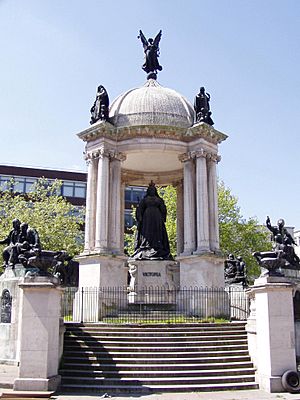Victoria Monument, Liverpool facts for kids
The Queen Victoria Monument is a huge and beautiful statue group in Liverpool, England. It stands in Derby Square, right where Liverpool Castle used to be. This monument is built in a fancy style called neo-Baroque or Beaux-Arts.
Contents
Building the Queen Victoria Monument
This amazing monument has 26 bronze figures. A famous sculptor named C. J. Allen created them. Some of his figures are in a style called New Sculpture. The monument was designed by F. M. Simpson from the Liverpool School of Architecture. He worked with a local company called Willink and Thicknesse.
The monument is made from a strong white stone called Portland stone. Its first stone was placed on October 11, 1902. A very important soldier, Lord Roberts, did this honor. The whole monument was officially shown to the public on September 27, 1906. Today, it is a Grade II Listed structure. This means it is a special building that needs to be protected.
Why Was It Built?
Experts like Sharples and Pollard say this monument is C. J. Allen's best work. They also believe it is one of the most impressive monuments ever made for Queen Victoria.
What Does the Monument Look Like?
There are four groups of figures around the bottom of the monument. These figures represent important things like farming, business, factories, and learning. One of the figures showing "learning" looks like a real person, Sir Oliver Lodge.
In the middle, there is a very tall statue of Queen Victoria. She stands about 4.42 meters (14.5 feet) high! Four groups of columns surround her. These columns hold up an open dome, like a fancy canopy. On top of these columns are four more figures. They represent justice, wisdom, kindness, and peace. At the very top of the dome, there is a large figure that stands for fame.
A Hotel Room on the Monument?
In 2002, something very unusual happened at the monument. As part of the Liverpool Biennial art festival, a Japanese artist named Tatsurou Bashi created a hotel room. He built it right around the statue of Queen Victoria! It was called Villa Victoria. People could actually pay to spend a night sleeping next to the Queen's statue.
Images for kids
-
The monument standing after the Liverpool Blitz during World War II.


